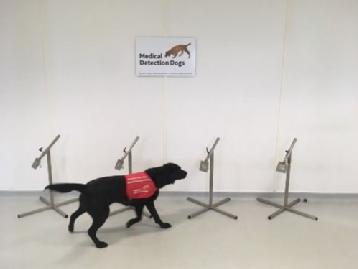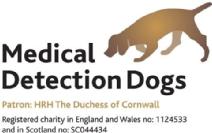Dr Katrina Holland on Overcoming Ambiguity and Negotiating Ambivalence in Medical Detection Dog–Trainer Relationships

Dr Katrina Holland reflects on the relationships between medical detection dogs and their trainers, observed during ethnographic fieldwork between 2016-2017.
Owing to their impressive olfactory capabilities, dogs have been used in a variety of scent-based tasks, from detecting explosives and drugs in police and military forces (e.g., Adamkiewicz et al., 2013) to identifying endangered species in conservation activities (e.g., Matthew & Relton, 2021). A more recent application involves training dogs to detect and alert to the odour of human diseases including cancer (Guest et al., 2021) and malaria (Guest et al., 2019).
Medical detection dogs are trained to identify the odour of their target disease within biological samples (e.g., sweat, urine, breath). To communicate what they have found to their trainer, the dogs are trained to perform behaviours; usually staring or sitting in front of positive samples and moving away from negative ones. In Bruno Latour’s (2004) analysis of a student learning to distinguish between subtly contrasting perfume scents, he employs the notion of affect to consider the body of the perfume student as an entity that, guided by a teacher, is undergoing “training to be affected”. Similarly, the dog trainers can be understood as gradually teaching the dogs to become affected in particular ways when they are presented with certain odours, which prior to their training would not have prompted them to respond in the same manner.

One of the medical detection dogs at MDD searches the samples. (Photo taken by Katrina Holland)
For the dogs, the behaviours they learn are “alien to any signaling behaviour they have evolved as a species” (Mancini et al., 2015, p.2673). Nevertheless, these behaviours are useful as they “translate” (Ibid.) the dogs’ spontaneous response to the odour into a behaviour that the human can readily interpret. This points to the asymmetrical structure of the training which is illustrative of the unequal power differentials between humans and dogs that underpin medical detection dog work, as well as training with animals more broadly (Haraway, 2008, p.336).
Described by some of my trainer participants as “biosensors”, on the one hand the dogs are understood as machine-like in their ability to perform conditioned behaviours in response to certain stimuli. When presented with samples, an ideal medical detection dog would perform a clear behaviour (e.g., confidently sitting down in front of a positive sample). In practice however, a dogs’ behaviour is not always so clear or confident. For instance, dogs may hesitate when performing their alert behaviour or move away and return to a sample. This presents a challenge for the trainers who, I argue, rely on a degree of interpretive flexibility to overcome such ambiguity. My findings suggest that trainers are compelled to become available and attuned (Despret, 2013) to the individual dog, honing their skill in “listening” to the dog, particularly via close attention to the movement of the dog’s body. Such practices highlight a contradictory perception of the dogs as agentic individuals with unique personalities.
The paradoxical definitions of medical detection dogs illustrated here, as machine-like instruments and minded individuals, is reflective of the ambivalence that is at the heart of relationships between humans and other animals (Herzog, 2010). This issue has previously been explored by Clinton Sanders (2006), in the context of police officers and patrol dogs, who notes that “dogs and other service animals are regarded both as ‘objects’ that serve, protect, and assist and as individual companions with whom one interacts and develops a shared emotional bond” (Ibid., p.149).
This brief assessment of medical detection dog training has suggested that both dog and human are affected by the other in the process. However, analysis of the training structure also highlights the fundamental asymmetry that underpins interspecies relationships. Research in the field of human-computer interactions (Mancini et al., 2015) might provide opportunity for mitigating the asymmetries observed in the human-centered structure of the medical detection dog training process. Through the design and use of a computing device that is informed by the dogs’ spontaneous behaviour and that can empower them to express the nuances of their responses, Mancini et al.’s multispecies participatory design project aims to re-center detection practices on the dogs and overcome the ambiguity inherent in current medical detection dog work.
Acknowledgments


This research was funded by the Economic and Social Research Council. With acknowledgment and thanks to the humans and dogs at Medical Detection Dogs and Penn Vet Working Dog Center who generously welcomed me into their worlds.
References
Adamkiewicz E., Jezierski T., & Walczak M. et al. (2013). Traits of drug and explosives detection in dogs of two breeds as evaluated by their handlers and trainers. Animal Science Papers and Reports, 31(3), 205–217.
Despret, V. (2013). Responding bodies and partial affinities in human–animal worlds. Theory, Culture and Society, 30, 51–76. https://doi.org/10.1177/0263276413496852
Guest, C.M., Doggett, M., Dewhirst, S., D’Alessandro, U., Kandeh, B., Morant, S.V., Pinder, M., Squires, C., Logan, J.G. and Lindsay, S.W. (2019). Trained dogs identify people with malaria parasites by their odour. Letter in Lancet Infectious Diseases, 19(6), 578-580 June 2019 https://doi.org/10.1016/S1473-3099(19)30220-8
Guest, C., Harris, R., Sfanos, K.S., et al. (2021). Feasibility of integrating canine olfaction with chemical and microbial profiling of urine to detect lethal prostate cancer. PLoS ONE, 16(2): e0245530 https://doi.org/10.1371/journal.pone.0245530
Haraway, D. (2008). When Species Meet. Minneapolis: University of Minnesota Press.
Herzog, H. (1993). Human morality and animal research. American Scholar, 62, 337-349.
Latour, B. (2004). How to talk about the body? the normative dimension of science studies. Body and Society, 10(2–3), 205–229. https://doi.org/10.1177/1357034X04042943
Mancini, C. Harris, R., Aengenheister, B., & Guest, C. (2015). Re-centering multispecies practices: a canine interface for cancer detection dogs. In: CHI '15: Proceedings of the 33rd Annual ACM Conference on Human Factors in Computing Systems, ACM Press, 2673–2682. https://doi.org/10.1145/2702123.2702562
Matthew, E.E., & Relton, C.E. (2021). Training methodology for canine scent detection of a critically endangered lagomorph: a conservation case study. Journal of Vertebrate Biology, 69(3), 20092, 1-14. https://doi.org/10.25225/jvb.20092
Sanders, C.R. (2006). The dog you deserve: ambivalence in the k-9 officer/patrol dog relationship. Journal of Contemporary Ethnography, 35(2), 148–172. https://doi.org/10.1177/0891241605283456
